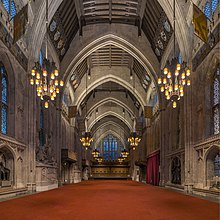
Guildhall, London
Guildhall, built between 1411 and 1440, was designed to reflect the importance
of London’s ruling elite. In the twenty-first century its splendor is still
awe-inspiring, and within the walls of this national treasure lie six
spectacular rooms providing unique surroundings for corporate and private
hospitality. Guildhall is a Grade I-listed building in the City of London,
England. It is situated off Gresham and Basinghall streets, in the wards of
Bassishaw and Cheap. The building has been used as a town hall for several
hundred years, and is still the ceremonial and administrative center of the City
of London and its Corporation. (It should not be confused with London's City
Hall, the administrative center for Greater London, of which the city of London
is only a small part. )#) The term "Guildhall" refers both to the whole building
and to its main room, which is a medieval great hall. The building is
traditionally referred to as Guildhall, never "the" Guildhall. The nearest
London Underground stations are Bank, St Paul's and Moor gates. Of course, it’s
not just this unique setting that creates a memorable event. The combination of
history and tradition with the very latest state-of-the-art built-in
communication technology helps to ensure that events are effective and
smooth-running. During the Roman period, it was the site of an amphitheater, the
largest in Britannia, partial remains of which are on public display in the
basement of Guildhall Art gallery and the outline of whose arena is marked with
a black circle on the paving of the courtyard in front of the hall. Indeed, the
siting of the Saxon Guildhall here was probably due to the amphitheaters remains
Excavations by MOLAS in 2000 at the entrance to Guildhall Yard exposed remains
of the great 13th-century gatehouse built directly over the southern entrance to
the Roman amphitheater, which raises the possibility that enough of the Roman
structure survived to influence the siting not only of the gatehouse and
Guildhall itself but also of the church of St Lawrence Jewry whose strange
alignment may shadow the elliptical form of the amphitheater beneath. The first
documentary reference to a London Guildhall is dated 1128 and the current hall's
west crypt may be part of a late-13th century building. Legendary British
history made Guildhall's site the site of the palace of Brutus of Troy.
No comments:
Post a Comment